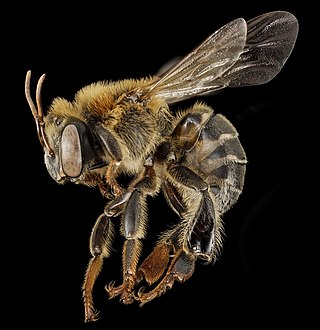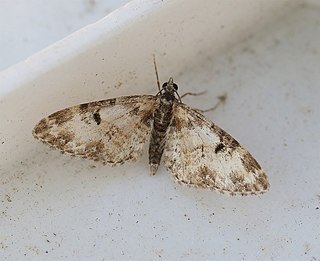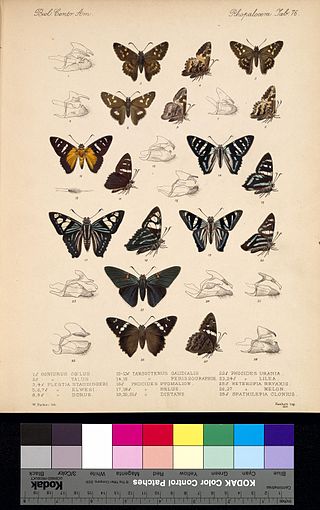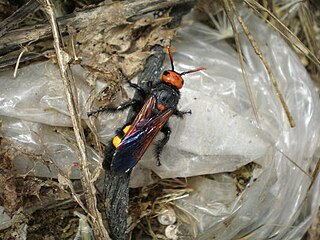
Carpenter bees are species in the genus Xylocopa of the subfamily Xylocopinae. The genus includes some 500 bees in 31 subgenera. The common name "carpenter bee" derives from their nesting behavior; nearly all species burrow into hard plant material such as dead wood or bamboo. The main exceptions are species in the subgenus Proxylocopa, which dig nesting tunnels in suitable soil.

Sceliphron, also known as black mud daubers or black mud-dauber wasps, is a genus of Hymenoptera of the Sphecidae family of wasps. They are solitary mud daubers and build nests made of mud. Nests are frequently constructed in shaded niches, often just inside of windows or vent openings, and it may take a female only a day to construct a cell requiring dozens of trips carrying mud. Females will add new cells one by one to the nest after each cell is provisioned. They provision these nests with spiders, such as crab spiders, orb-weaver spiders and jumping spiders in particular, as food for the developing larvae. Each mud cell contains one egg and is provided with several prey items. Females of some species lay a modest average of 15 eggs over their whole lifespan. Various parasites attack these nests, including several species of cuckoo wasps, primarily by sneaking into the nest while the resident mud dauber is out foraging.

Deudorix is a large genus of butterflies in the family Lycaenidae. The species of this genus are found in the Old World and Australia.

Melipona is a genus of stingless bees, widespread in warm areas of the Neotropics, from Sinaloa and Tamaulipas (México) to Tucumán and Misiones (Argentina). About 70 species are known. The largest producer of honey from Melipona bees in Mexico is in the state of Yucatán where bees are studied at an interactive park called "Bee Planet" which is within the Cuxtal Ecological Reserve.

Eupithecia irriguata, the marbled pug, is a moth of the family Geometridae. The species can be found in Europe and North Africa.

Muschampia is a Palearctic genus of spread-winged skippers in the family Hesperiidae.

Zestusa is a genus of skippers in the family Hesperiidae subfamily Eudaminae. Species of the genus occur in Mexico and the western United States.

Lasionycta staudingeri is a moth of the family Noctuidae. It can be found from Oppland to Finland and Norway in Europe, as well as Siberia and North America.
Tulaya is a genus of moths of the family Crambidae. It was previously named Hercynella but that name was pre-occupied by a genus of fossil molluscs.

Troides staudingeri is a birdwing butterfly in the genus Troides in the family Papilionidae. It is known from Leti Island, Moa Island, Kisar Island, Babar Island and Wetar Island.

Bebearia is a genus of brush-footed butterflies. The species are confined to the Afrotropical realm, mainly in the Guinean Forests of West Africa and the Congolian forests.

Chazara staudingeri is a butterfly species belonging to the family Nymphalidae. It can be found from the Pamirs-Altai to Inner Tian-Shan.

Colias staudingeri is a butterfly in the family Pieridae. It is found in Turkmenistan, Tajikistan and Uzbekistan. The habitat consists of alpine meadows at altitudes between 2,000 and 3,900 meters.

Colias leechi is a very little known butterfly in the family Pieridae. It was described from the East Palearctic "In ramificationibus occidentalibus montium Himalayensium in valle Chonging".

Eublemma staudingeri is a species of moth of the family Erebidae. It is found in Eritrea, Niger, Nigeria, South Africa, Yemen and Zimbabwe.

Tetragonula is a genus of stingless bees. In 1961, Brazilian bee expert J.S. Moure first proposed the genus name Tetragonula to improve the classification system by dividing the large genus Trigona stingless bees into 9 smaller groups. About 30 stingless bee species formerly placed in the genus Trigona are now placed in the genus Tetragonula. These bees are found in Oceania, in countries such as Australia, Indonesia, New Guinea, Malaysia, Thailand, the Philippines, India, Sri Lanka, and the Solomon Islands. The most recent tabulation of species listed 31 species.

Megascolia is a genus of large solitary wasps from the family Scoliidae, the species classified under Megascolia include some of the world's largest wasps. They are parasitoids of large Scarabeid beetles such as the European rhinoceros beetle Oryctes nasicornis and Atlas beetle Chalcosoma atlas.

Hoplisoides is a genus of sand wasps in the family Crabronidae. There are at least 70 described species in Hoplisoides.
Paratrigona is a genus of bees belonging to the family Apidae.

Dactylurina is a genus of bees first described in 1934.
















